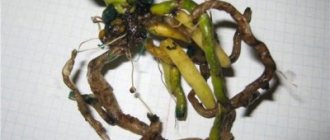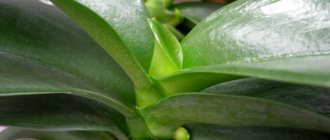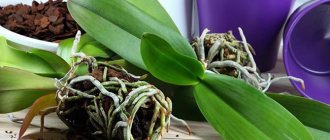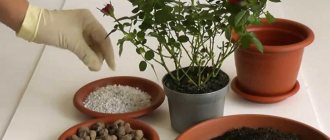Life cycle
First, the orchid actively grows green mass and root system. To enter the flowering stage, it needs a full rosette of 5-8 strong leaves . It takes from 1.5 to 3 years to form and strengthen the roots.
The flowering period lasts from 3 to 10 months. At this point, foliage and root growth slows down. It will resume after the plant has flowered and remains dormant for 2-3 months. Then the formation of new flower stalks will begin.
Top dressing
Like any other crops, orchids need feeding. But it must be done carefully, using fertilizers intended only for orchids. Universal fertilizers are not suitable for phalaenopsis. If you still decide to use them, reduce the recommended concentration by 2 times.
An excess of useful elements can cause leaves to drop. Therefore, it is recommended to feed the orchid only before flowering and during budding. But it is recommended to refrain from using fertilizers directly during flowering. These little simple tricks will help you admire orchid blooms for as long as possible.
- Author: iarriba
Rate this article:
- 5
- 4
- 3
- 2
- 1
(8 votes, average: 4.1 out of 5)
Share with your friends!
What is needed for flowers to appear?
For normal development and growth of the orchid, it is necessary to maintain an appropriate microclimate in the room. The plant will bloom profusely if you adhere to the following recommendations :
- Use only transparent containers for growing phalaenopsis. Its root system also takes part in photosynthesis, so they need constant access to light.
- Do not plant the flower in pots with embossed walls or sharp corners, otherwise the roots will grow to the uneven surface or may be injured.
- Choose a permanent place for the container with the orchid and do not move it even during watering. Moving causes stress and slows down metabolic processes.
- Provide sufficient lighting. The duration of daylight should be at least 10-12 hours. In the cold season, its deficiency is compensated for by phytolamps, which provide bright light, but do not dry out the air near the flower and do not overheat it.
- Maintain humidity levels between 60-70%. If the room is too dry, place a glass of water near the pot or spray the leaves with a spray bottle.
Reference . When bred at home, phalaenopsis blooms mainly in the cold season. Its flowering period lasts from November to March-April.
Reasons for absence
Healthy orchids do not produce flower stalks for several reasons.:
- they have not yet reached adulthood;
- the indoor microclimate is too comfortable - without a difference in night and day temperatures, as in nature;
- lacks nutrients.
Knowing what exactly prevents flowering, you can easily correct the situation. Sometimes it’s enough just to wait for the plant to grow or feed it.
The peduncle has faded: next steps
Depending on the variety of gardeners’ favorite, its peduncle can stimulate the appearance of new ones and form buds. For example, when the peduncle of Phalaenopsis has faded, it needs to be cut off.
When the peduncle has faded, it either dries up or grows and forms new buds. Regardless of the scenario, the plant needs special care during this period.
The dried peduncle does not need to be removed immediately; this is done when the plant stops the drying process. When this happens, you need to cut off the entire peduncle at the root and leave a small piece of the peduncle, no more than two centimeters high. But this is done only when there are no young branches with buds on it.
If the peduncle continues to grow, then the orchid needs to be fed. This is done once every three weeks.
Differences between home and nature
The life cycle of an orchid remains unchanged even when grown at home . It is divided into 3 stages:
- height;
- bloom;
- peace.
The only difference is that in its natural habitat the plant blooms longer , and the flowers themselves are larger and brighter. In nature, phalaenopsis has constant access to the required amount of nutrients, and the level of humidity and light fully corresponds to its needs.
Caring for phalaenopsis at home
Growing conditions
Caring for phalaenopsis consists of choosing a place for the flower, properly organized watering, fertilizing, temperature conditions and protection from pests and diseases. It is best to place a pot of phalaenopsis on a western, eastern or northeastern windowsill.
If this is not possible, and you have to place the orchid on the south side, place it on a table near the window, behind a curtain that creates a light shadow - direct sunlight leaves burns on the plant that look like spots on the leaves and flowers of phalaenopsis. Every 2-3 weeks, turn the plant 180º so that it does not lean to one side. But during the formation of buds it is better not to disturb the plant.
Phalaenopsis blooms in partial shade at a temperature of 18-25 ºC, and the plant can tolerate higher temperatures for some time, up to 35 and even 42 ºC, and lower temperatures - up to 12 ºC. But do not test the strength of phalaenopsis, try to keep the temperature within 15-25 ºC.
Air humidity is required at 30-40 percent, and good ventilation of the room is necessary. With insufficient humidity, the leaves lose turgor and the flowers fall off. To avoid such trouble, place the plant on a tray with wet pebbles. Too high humidity can cause rotting of the orchid roots and spots on the leaves.
Spraying phalaenopsis is undesirable even in very hot weather, since water flows into the core and axils of the leaves, which can lead to rotting of the plant. In addition, moisture evaporating from the surface of the leaves can cause them to burn.
Fertilizer
Phalaenopsis is fed during watering by adding Kemira-Lux complete complex fertilizer to the water at the rate of 1 g per 1 liter twice a month. You can feed the orchid weekly, but then the concentration of the fertilizer needs to be reduced. Fertilizer is poured only onto a damp substrate.
How to water
Watering phalaenopsis is carried out after the soil has completely dried, but it should not remain dry for a long time. If you grow phalaenopsis in a transparent container, then a signal that it is time to water the orchid is the lack of moisture on the walls of the pot. In addition, due to lack of moisture, the green roots of the flower become lighter. If the container is opaque, you will have to rake the substrate to determine how deeply it has dried.
Do not water the orchid over the leaves, water the substrate, or use the method of bottom watering the orchid - immerse the flowerpot in a container of water to saturate the substrate with moisture through the drainage holes. The water for watering phalaenopsis must be soft and clean: it is not enough to filter the water, it also needs to be boiled. Or use distilled water for watering.
Once a month, phalaenopsis likes to take a shower or wash itself under the tap, after which the plant should be wiped dry. Avoid overwatering the phalaenopsis, otherwise its leaves will become limp and the growing point may rot. In the best case, the orchid will develop a side shoot, in the worst case, the plant will die.
How to transplant
In what cases is phalaenopsis transplanted? When the plant is in the same pot and in the same substrate for 2-3 years. Usually, by this time the substrate cakes, turns sour and becomes unusable, therefore, it needs to be replaced. If you notice strong branching of the roots and their growth through the drainage holes, this is also a sign that it is time to replant the phalaenopsis orchid. This should be done after flowering.
If your orchid is not sick in any way and is planted in a substrate of a large fraction, then it can be carefully transferred to a new, large container with a drainage layer and topped with fresh substrate, the main component of which is the bark of the small and medium fraction. In addition, the substrate for phalaenopsis includes sphagnum moss. You can purchase a ready-made substrate, or you can buy the ingredients and carefully prepare a mixture for your overseas beauty: place drainage made of expanded clay or pieces of foam at the bottom of the pot, then medium-fraction bark, then fine-fraction bark mixed with crushed moss. Please note that dry bark quickly allows water to pass through, so before making a substrate out of it, you need to rinse it and leave it in water for a couple of days to swell, then rinse the bark again in clean water.
- Types of indoor trees
How to trim
If the phalaenopsis has faded, watch for a while how the old arrow behaves. If it begins to turn yellow and fade, then remove it without regret, but if it is still green and juicy, then, most likely, after a two-month rest, flower buds will appear on it again. The new arrow must still grow, and only then lay buds and produce flowers. If the old arrow is too long, shorten it by cutting 1 cm above the developed bud.
By the way, the lower you cut the peduncle, the more flowers there will be on the side arrow. In any case, there is no need to cut the peduncle below the third bud: you will have to wait a long time for flowering on the shortened arrow.
Step-by-step instructions for stimulation
If the orchid has reached the age of 2-3 years, but does not bloom, artificial stimulation will be needed. But this method can only be used for healthy plants with a strong root system and powerful leaves.
How to make it produce buds?
You need to create a stressful situation for the flower. To do this you need:
- Take 10 liters of water and wait for it to settle for 24 hours. Then the leaves and roots will not suffer from high concentrations of chlorine.
- Heat the settled water to 40-45 degrees.
- Place the orchid pot in it for half an hour.
Attention! The water should be warm enough and tolerable for the skin of your hands, but not hot so as not to burn the plant.
After the procedure, the container with phalaenopsis is placed in its original place.
Video on how to make an orchid bloom:
How to extend the process?
You can increase the duration of flowering by adjusting the lighting mode . This is done as follows:
- In winter, a phytolamp is installed above the orchid pot. The light should be diffused, not intense.
- Additional light is turned on in the evening to extend daylight hours to 12 hours.
- After the buds bloom, the duration of daylight hours is reduced to 10-11 hours.
- And if the plant produces a peduncle in the summer, the window is shaded so that the direct rays of the sun do not fall on it. As a result, the lifespan of each flower increases by 3-4 days.
Video on how to prolong the flowering of an orchid:
Planting and caring for phalaenopsis
- Flowering: any time from 2 to 6 months.
- Lighting: bright diffused light (windows of western, eastern or north-eastern orientation) or light partial shade.
- Temperature: maximum – 42 ˚C, minimum – 12 ˚C, comfortable – within 15-25 ˚.
- Watering: after the soil has completely dried.
- Air humidity: 30-40% with good ventilation of the room.
- Feeding: with a solution of complete mineral fertilizer weekly.
- Rest period: not clearly expressed.
- Replanting: as the substrate sours and cakes, approximately once every 2-4 years.
- Reproduction: vegetatively (by side shoots).
- Pests: mealybugs, spider mites, thrips, scale insects, slugs.
- Diseases: fusarium, rust, anthracnose, spotting, black, brown, gray and root rot.
Read more about growing phalaenopsis below.
Phalaenopsis flowers (lat. Phalaenopsis) are herbaceous plants of the Vanda tribe of the Orchid family, native to the rainforests of Australia, Southeast Asia and the Philippines. Phalaenopsis orchids are mostly epiphytes because they grow on trees, but sometimes they also grow on rocks. The first phalaenopsis on one of the Moluccas islands was discovered by the German naturalist Georg Rumph, but the flower received its name from Karl Blum, director of the Leiden Botanical Garden, who, looking at the exotic orchid through binoculars, mistook it for a butterfly, and therefore called it phalaenopsis - “like a moth.” And to this day, flower growers call these flowers “butterfly orchids.”
The Phalaenopsis genus has about seventy species. The phalaenopsis flower, which is sold in flower shops, is incredibly popular not only because of its exquisite and extraordinary beauty, but also because growing and maintaining phalaenopsis does not cause trouble and does not require costs.
How to care?
At each stage of development, the orchid requires certain attention. During the period of active formation of flower stalks, it needs watering and additional nutrition . And after flowering, the plant is prepared for the resting phase and sanitized. And if everything is done correctly, after a few months the flower will again delight you with blooming buds.
During the period when the plant blooms
During this period, phalaenopsis needs the following activities:
- Regular moisturizing . At the stage of peduncle formation, the interval between waterings is reduced, otherwise the buds will quickly fall off due to lack of moisture. But you also can’t over-water the soil; it must dry out completely before the next irrigation. For irrigation, use only warm and settled water.
- Fertilizer application . Fertilizers are selected on a potassium and phosphorus basis, with a low nitrogen concentration. This will speed up the formation of buds and extend the flowering period.
- Additional fixation . If you want to get an erect peduncle with a cascade of flowers, you need to use a vertical support even at the stage of its growth.
- Protection from drafts and maintaining humidity at a level of at least 60% . To do this, place a small reservoir of water next to the pot or gently spray the leaves with a spray bottle.
- Artificial lighting to extend daylight up to 12 hours . Will be needed during the cold season or cloudy weather.
Important! After the buds open, the orchid should not be disturbed. This applies to both her place of stay and changes in her conditions of detention. At this time, only the frequency of watering is changed.
Aftercare
As soon as the last bud falls, the flower needs to be prepared to enter the dormant stage . To do this you need:
- Inspect the condition of the roots. A healthy root system has a gray or green tint. If there are dry or rotten roots, carefully trim them with scissors. Immediately sprinkle the cut areas with ash.
- Sanitize the leaves and stem. Remove areas with stains and rot. This will help avoid complete infection of the plant.
- Reduce the room temperature by 2-3 degrees.
- Reduce the frequency of watering and stop fertilizing.
The resting phase of an orchid lasts from 3 weeks to 3 months . At this time, she restores her strength for the next flowering.
Support
As soon as the orchid begins to bloom, its shooters feel strong tension. Due to the heaviness of the flowers, the peduncle may break, and then you will not be able to enjoy the beauty of the orchid buds for a long time.
To avoid trouble, install a support. Moreover, this must be done immediately after the buds appear. Fix the arrow with a special clamp, crab or clothespin. As the peduncle grows, the clamps are moved.
If the arrow of the plant is high, it will still bend under the weight of the flowers, but only from above. With the support installed, there is no need to be afraid of this - the edge of the peduncle is flexible, it can withstand such a load.
Possible problems
If the phalaenopsis does not have enough light or moisture at this time, this leads to the following consequences:
- drying of flower ovaries;
- reducing flowering time;
- rapid fall of flowers.
But direct sunlight is also harmful to a blooming orchid. They can cause burns. If the pot is on the south side of the house, the window is slightly shaded.
also reacts sharply to extreme heat . To avoid exposing it to heat stroke, the room must be periodically ventilated, but avoid drafts. Otherwise, the leaves will lose their elasticity and begin to wither, followed by the interruption of the flowering process.
Daily temperature changes are also important for a flower. The difference between the indicators should be within 4-7 degrees. If the temperature is the same day and night, the buds will wither faster. Best option:
- during the day, maintain the air temperature at +25-27 degrees;
- and at night – from +18 to +20.
A lushly blooming orchid is the result of proper care and careful treatment of it. If you create a suitable microclimate for phalaenopsis indoors and use additional stimulation methods, it will bloom from 3 to 10 months. And in order to achieve repeated flowering, you need to give the flower the opportunity to restore its strength during the dormant period.
How to know when orchids should bloom
Orchid flowers have an exotic shape and look like butterflies for a reason. They really look like female moths living in tropical countries. The phalaenopsis orchid even received its name in memory of the mistake of the scientist who discovered it.
A botanist in the dark mistook phalaenopsis flowers for moths. This is an evolutionary adaptation of orchids that allows the plant to lure male butterflies and force them to pollinate flowers in an attempt to find a true female to mate with. For this reason, orchids at home begin to bloom when conditions similar to those in nature are created.
There is no mathematically verified answer to the question “when will an orchid begin to bloom.” The answer to this depends on the ability of the orchid grower to create conditions suitable for flowering for the plant. For most orchids, after flowering, a dormant period begins, during which the plants' need for water and nutrients decreases.
Dendrobium King after flowering requires “leave it alone”, lowering the air temperature by 5 °C and reducing the number of waterings to once every 3 months. This flower should remain dormant for several months. Usually this is autumn - winter. The rest of the plants are not subject to such harsh conditions, but almost all of them need some time to gain strength for re-flowering.
A pleasant exception is phalaenopsis, which is characterized by a significant duration of flowering and an almost complete absence of a dormant period. How often a phalaenopsis orchid blooms directly depends on its care, the amount of nutrients that the orchid receives when watering, and the temperature and lighting in the room. Unlike other orchids, blooming phalaenopsis can decorate a room almost all year round. To the point that there are legends among orchid growers that some masters are able not only to make orchids bloom all year round, but also to give bouquets of cut orchid flowers when visiting.
Diseases and their treatment
Phalaenopsis suffer from both infectious and non-infectious diseases. In both cases, the main cause of the disease is errors in plant care.
- What you need to know about growing hippeastrum
Of the fungal diseases, fusarium most often affects phalaenopsis, in which the roots of the plant first become ill, and then the disease spreads to the entire orchid. The main cause of fusarium, like other rots, is excess moisture. It is impossible to cure phalaenopsis from fusarium, so the plant is destroyed. But other rots (black, brown, root, gray, as well as diseases such as rust, anthracnose and spotting) are sometimes cured by two-time treatment with a fungicide (foundazol or, for example, topsin-M) with an interval of 10 days.
A common disease in phalaenopsis is urticaria, which affects the leaves at an early stage with large spots 2-3 cm in diameter. The culprit is low air temperature, high humidity and poor air exchange in the room. Eliminate deficiencies in care, and everything will go smoothly.
And from a disease such as botrytis, the plant suffers in conditions of high air humidity and poor ventilation in the room, but it affects not the leaves, but the phalaenopsis flowers: first, dark brown spots appear on the petals, then the petals fade. If you raise the temperature in the room, the disease will slow down its progression. In addition, ensure good ventilation of moist air in the room and treat the plant with a bactericidal preparation.
Non-infectious diseases are caused by the use of pesticides, excessive lighting, improper feeding, uneven watering and are expressed by drying of the tips of the leaves, necrosis of the roots, damage to other plant tissues and all kinds of spotting. Find and eliminate the cause of the disease, and, quite likely, you will be able to save your orchid, but you should know that resuscitation of phalaenopsis is a labor-intensive process and is not always successful.
FAQ
How to plant a baby Phalaenopsis orchid?
After you have separated the baby from the mother plant, soak it in a growth hormone solution for about a quarter of an hour. In this way, you will ensure the rapid development of the root system, and also slightly soften the already formed roots and make them easy to place in the pot.
At first, the plant should grow in a special pot for orchids (with a large number of plants) and in a special substrate.
To maintain a high level of humidity, it is better to cover the pot with the plant with a transparent plastic bag. At the same time, it is important to shade the orchid so that it does not burn.
Sticky drops on the leaves of the Phalaenopsis orchid.
There may be several reasons.
- The appearance of pests: scale insects, aphids, scale insects.
- Failure to comply with the rules for keeping orchids.
If, upon inspection of the plant, traces of insects were found, it should be immediately treated with chemicals. If the plant looks healthy, pay attention to the air temperature in which Phalaenopsis is kept. As a rule, sticky spots appear due to sudden changes in temperature, and also if day and night temperatures are the same.
You can remove sticky plaque with plain water using a cotton swab.
The leaves of the phalaenopsis orchid are turning yellow.
Remember that if the lower leaves of a plant turn yellow, this is a natural process. As a rule, the lower leaf turns yellow at the same time as the new one grows.
If the leaves turn yellow and rot, the plant has most likely been flooded with water. In this case, you should reduce watering and be sure to inspect the roots and check for rot on them. Leaves may also turn yellow from too much sunlight. In this case, simply move the pot to a darker place.
Yellow spots may appear due to a chemical burn if you fed the plant with a too concentrated fertilizer solution.
Small yellow spots that are located dotted on the leaves indicate the presence of parasites. In this case, special chemicals will help.
The leaves of the Phalaenopsis orchid are withering.
Droopy leaves primarily signal that you need to pay attention to the root system. Most likely, the roots do not supply the leaves with the required amount of moisture. This is due to overdrying of the substrate. To correct the situation, just place the pot with the plant in water for 10-15 minutes. It is also necessary to spray the leaves. If after watering and spraying the plant does not regain its previous appearance, more serious action is required.
It is necessary to remove the plant from the pot and lightly clean the roots. All gray and brown roots must be cut off. Treat the cut areas with sulfur or charcoal. You can also use special growth stimulants. Then replant the plant in the pot and spray. To speed up the growth process, you can place the orchid in a greenhouse. For this you can use an aquarium or a plastic container. The greenhouse must be ventilated once every few days.
Choose a place for the greenhouse that is bright and warm.
You can transplant the orchid into a new pot after six months. The peduncle of a Phalaenopsis orchid is drying up.
If the peduncle begins to dry out, this indicates that the plant has exhausted its strength and needs a break from flowering. Wait until the peduncle dries completely and cut it lower towards the stem.
Pests and their control
In addition to diseases, phalaenopsis and pests also exhaust them. For example, a small insect such as a mealybug causes yellowing and falling leaves. It is destroyed by treating the leaves and stems with an aqueous solution of laundry soap.
Spider mites, which attack any plant when there is insufficient air humidity, can also harm phalaenopsis. The mite expresses its presence with a silver web on the leaves, as if pricked with a needle. If you find a spider mite at the very beginning of occupying a plant, you can remove it, like aphids and mealybugs, with a soap solution, but if the matter has gone far and the pest has firmly settled on your orchid, you will have to use acaricide treatment to combat it.
Sometimes thrips infect the leaves and flowers of phalaenopsis, covering them with brown spots. You have to fight them with actellik or another systemic insecticide (hostaquik, isatrin), but it is best to use the less toxic drug fitoverm.
If you find tubercles on the leaves of phalaenopsis, know that your flower has been chosen by scale insects, which will suck the juice from the orchid, as a result of which it will begin to wither. Treat scale insects the same way you would treat scale insects: treat them twice with soapy water, a week apart.
Phalaenopsis suffers the worst from slugs, since these rather large creatures simply eat the leaves, stems and even flowers of the orchid. Place a few pieces of carrot or cucumber on the ground and wait until the slug appears to drag the vegetable away and move it away from the flower. If you cannot physically collect the slugs, use insecticides such as metaldehyde or mesurol.
Despite the above troubles, phalaenopsis are among the least problematic orchids, which, with proper care, are very rarely subject to insect attacks or infection with any diseases. As a rule, they live and bloom happily ever after in a city apartment, to the delight of their caring owner and their own pleasure.
The main thing that the happy owner of an orchid needs to learn: balanced watering of the phalaenopsis, sufficient lighting, adjusted temperature conditions and timely feeding will make his orchid not only a beautiful flowering plant, but also a plant completely invulnerable to pests and diseases.
What can we do to make the buds appear faster?
But still, this does not mean that nothing needs to be done (or that it is impossible to provide the plant with care that will have a beneficial effect on flowering and its timing). It is almost impossible to control the flowering of phalaenopsis in the classical sense. If other orchids can be “programmed” with strict regimes and alternating periods, then phalaenopsis is not one of such predictable species. Fortunately, they don’t need any wisdom to lay flower buds and develop flower stalks - you just need to trust natural processes.
The most reliable tactic is to try to provide the phalaenopsis with conditions and care that are as close to ideal as possible. After all, the period of the formation and growth of the peduncle itself, and everything that happened before that, is also important. And if you have doubts or a desire to prevent possible mistakes, you can always closely monitor the three main points that determine the flowering of phalaenopsis:
- A schedule of watering and fertilizing that should correspond to the development of the plant.
- Temperature regime.
- Lighting quality.
For hybrid phalaenopsis, which fill shelves en masse and are so popular, it is watering and humidity that is the key to success or failure. Even without adjusting the lighting or temperature, proper “watering” stimulates the growth of the peduncle.
Tireless Phalaenopsis Orchid
The usual rest period in phalaenopsis is completely absent. This unique orchid develops and grows throughout the year, and there is always something happening with it. And what in other orchids is a phase of preparation for future flowering under strict conditions, in phalaenopsis is only part of the ongoing active development from flowering to the beginning of the growth of the next peduncle.
During the growing season, not only does one, or less often two, leaves and new roots grow, but buds are also formed in invisible buds, which can begin to grow in a couple of weeks or several months later. Since it is impossible to notice the moment of formation of flower buds, it is worth considering that the period of waiting for the next flowering in phalaenopsis starts as soon as the last flower withers.











